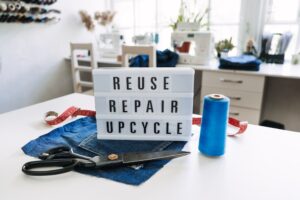Jeans are a staple in many of our wardrobes. They are versatile and can be dressed up or down for any occasion. However, their production can be resource-intensive and have a significant environmental impact. Jeans can have a high carbon footprint from the water and energy required to produce the cotton to the harmful chemicals used in the dyeing process.
But it doesn’t have to be this way. With the growing awareness of sustainable fashion, there are ways to make more eco-friendly choices when it comes to jeans. In this post, we’ll cover tips for sustainable shopping, repurposing, and disposal of jeans, all of which will help you to make more environmentally conscious choices.
Sustainable Shopping Tips for Jeans
One of the most important ways to make sustainable choices when it comes to jeans is to choose materials that are better for the environment. Organic cotton, hemp, and recycled denim are all sustainable options. These materials require less water and fewer pesticides than conventional cotton, one of the most resource-intensive crops. When shopping for jeans, it’s important to check the label to see what materials the jeans are made from.
Another important consideration when shopping for sustainable jeans is the manufacturing process. Look for brands that prioritize sustainability in their production process. Brands that use renewable energy reduce water consumption, and minimize waste are often the most eco-friendly options. To verify their sustainability claims, consider checking the brand’s website or third-party certifications like the Global Organic Textile Standard (GOTS) or the Better Cotton Initiative.
When it comes to the fit and style of the jeans, consider choosing high-quality jeans that are made to last. High-quality jeans are often designed with stronger stitching and durable materials, reducing the need to replace them frequently. Additionally, look for classic styles that won’t go out of fashion quickly, reducing the need to buy new pairs frequently.
In addition to the materials and manufacturing process, it’s important to consider the ethical standards of the brands you choose. Look for brands prioritizing fair labor practices and ethical working conditions for their workers. Some certifications include Fair Trade or WRAP (Worldwide Responsible Accredited Production).
Repurposing Ideas for Old Jeans
When your jeans reach the end of their useful life, there are plenty of ways to repurpose them instead of throwing them away. Repurposing old jeans keeps them out of landfills and creates unique and personalized items. Here are a few ideas for repurposing old jeans:
- Denim shorts: Cut off the legs of old jeans to create a new pair of shorts.
- Patchwork: Cut up old jeans into patches and use them to mend holes in other clothing items or to create a patchwork quilt.
- Tote bag: Cut the legs off of old jeans and use them to create a denim tote bag.
- Denim skirt: Cut off the legs of old jeans and sew them together to create a denim skirt.
- Upholstery: Use old jeans to cover pillows, cushions, or furniture for a durable and unique look.
- Apron: Use old jeans to create a stylish and functional apron.
- Storage: Use old jeans to create storage baskets, pencil cases, or other organizational items.
Another way to repurpose old jeans is to use them as a base for custom embroidery or painting. Create unique designs or add embellishments to the fabric to make your jeans truly one-of-a-kind.
Disposal Options for Jeans
If repurposing is not an option, there are several other ways to dispose of jeans in an eco-friendly way. Donating or selling your old jeans is a great way to extend their lifespan and keep them out of landfills. Consider donating them to thrift stores or clothing donation centers that accept used clothing. Many organizations will resell the clothes, with the profits going to support community programs.
If you’re looking to sell your old jeans, consider using online platforms like Poshmark, eBay, or Depop. These platforms allow you to sell gently used clothing directly to buyers, giving your old jeans a new life with someone else who will appreciate them.
If your jeans are too worn out to donate or sell, textile recycling programs are a good option. These programs sort clothes and either resell or recycle the textiles. Some cities have curbside textile recycling programs, while others have drop-off locations. You can check with your local waste management agency or visit the website of the secondary materials and recycled textiles (SMART) association to find a textile recycling program near you.
If your jeans are made from sustainable materials like organic cotton or hemp, they may be compostable under the right conditions. However, not all home composting systems can break down these materials, so it’s important to research local composting options. A landfill should be a last resort when it comes to jeans, as it contributes to the accumulation of waste.
Final Thoughts
Jeans are a staple in many of our wardrobes, but their production can have a significant environmental impact. By making sustainable choices when shopping for jeans, repurposing old jeans, and disposing of them in an eco-friendly way, we can reduce the impact and contribute to a more sustainable future. Remember to choose sustainable materials, consider the manufacturing process, and repurpose or recycle your old jeans whenever possible. Together, we can positively impact the planet and the fashion industry.









Reader Interactions